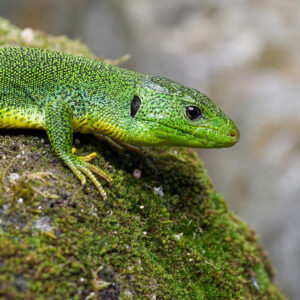Copyright 2021 Evolution Reptiles
All rights reserved.
Copyright 2025 Evolution Reptiles
All rights reserved.
All rights reserved.
The Balkan Green lizard Lacerta trilineata is the biggest species of European Green Lizard and one of the most visually impressive reptiles found in mainland Europe. These lizards have a large range spanning the Adriatic Coast, the Southern Balkans and Crete where they often inhabit dry shrubland. You can find them in the wild both at sea level and 1500m above it, in montane regions of Crete. As juveniles they have stripes and exhibit a rather bland brown colouration with subtle hints of green, but they truly flourish as they mature. An adult specimen will lose these stripes and often have stunning, emerald green scales spanning the length of their body with a slight blue tinge along the sides. They attain lengths of up to 45cm including the tail and have a strongly insectivorous diet, so a good variety of bugs will need to be offered.

In order to care for these lizards in captivity, it is important to understand how to provide them with a suitable environment. A wooden vivarium of at least 4 ft (120cm) in length, and 2 ft (60cm) in depth and height, will work best for this species. This allows this very active species ample space to exhibit natural behaviours, while providing enough room for a suitable temperature and UVB gradient. Some like it hot, and that is certainly the case for these green gems. We would aim for a basking spot of around 40⁰C, with the ambient temperature staying between 25⁰C and 30⁰C. This is most easily achieved by providing a high wattage basking lamp attached to the middle of the ceiling, about ¾ of the way along your vivarium. They are also a diurnal species which is regularly spotted basking during the brightest parts of the day. This is why they belong to the Ferguson Zone 3, meaning they will need access to a UVI (UltraViolet Index) of between 2.9 and 7.4. A high output UVB tube used with a reflector should achieve this for you, along with plenty of raised basking areas and a few darker, shaded areas for privacy.
Wild specimens are often found living in and around shrubs throughout arid regions, it would therefore be beneficial to try and recreate this kind of environment for them in captivity.
Copyright 2021 Evolution Reptiles
All rights reserved.